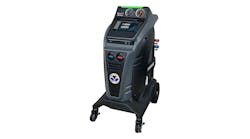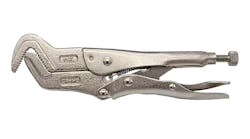In this month’s column, we take a look at suspension dos and don’ts, offer tips on running stubborn monitors and share a lesson learned by one of our TST members.
Uncooperative Monitors
As a professional, you understand that the last step in any repair is to verify the success of that repair. Diagnosing and repairing a Check Engine Light complaint also might involve rerunning all the system monitors to make sure a secondary problem, temporarily covered up by the first, isn’t hiding in the wings waiting to bite you on your backside. You dutifully follow the OEM procedures for running a total drive cycle, but when you return to the shop you find that some of the computer monitors have not completed their testing. Here are a few things to check to help you get those stubborn monitors to complete.
Peened edges or retaining clips aren’t designed to make up for sloppy fits.
First, are any new Diagnostic Trouble Codes (DTCs) stored pending or Freeze Frame? If so, they might be suspending testing on other systems. That is what you wanted to find out, right? Repair as needed and perform another complete drive cycle.
Second, are all the conditions needed to run the incomplete monitors met? That includes commonly overlooked things like the amount of fuel in the tank, battery/system voltage levels, the ambient air temperature and engine operating temperature. On some models, you may need to insure that the crankshaft relearn has been successfully completed and that the required cold soak time has been met. All of the information telling you what conditions are needed can be found in your service information system.
Measuring firing demand and burn time can tell you about more than just the health of the ignition system.
When beginning your generic drive cycle test drive, make sure that the engine has not been started for eight hours, followed by an engine that is warmed up to normal operating temperature before driving. Get in at least 10 continuous minutes of highway speed driving and 20 minutes of stop-and-go city driving, with at least four idle stops that are two minutes each. Be sure that you don’t turn off the key at any time or you’ll have to start over again. Once completed, make sure you turn of the engine and wait two minutes before turning the key back on to check the monitor status.
There are tools on the market that connect to the Diagnostic Link Connector (DLC) and provide a visual indication that the monitors have completed that also might prove helpful. Some monitors, like the EVAP monitor, might be able to be completed with the car sitting in the bay using an appropriate scan tool.
Firing kV Diagnosis
TST member Alex Portillo was dealing with a misfire on a Toyota Rav4 and used a new tool we had to check the ignition output of the Coil On Plug (COP) ignition system non-intrusively. The General Tools TA500 tester uses a probe tip, so if you can reach the coil you can check it.
He found one coil that was firing at a lower voltage than the others. Now the question becomes, “Why?” The tool measured a peak firing voltage of 6.9 kilovolts (6,900 volts) and a burn time across the plug gap of 2.30 milliseconds on the low cylinder. The other cylinders recorded firing voltages more in the range of 11.7 kilovolts (11,700 volts) and substantially shorter burn times of 1.8 milliseconds.
Head gasket leaks can be slow, or occur only after the engine has reached operating temperature. Don’t rely on visual signs alone.
If we were looking at this information on a scope, the firing line on the weak cylinder would be lower but the burn line would be longer than all the others. It helps to think of the entire pattern as a length of rope. A good coil will produce a certain amount of energy, and if the firing demand is higher than it should be there is less left over to sustain the spark. The same is true in reverse. If the firing demand, for some reason, is lower than there is more energy left to maintain the burn time.
At first, Portillo suspected a weak coil. Had that been true, odds are the burn time recorded would have been the same or even less than the companion cylinders. What else impacts firing time?
The spark plug gap, the fuel molecules in the gap, and the amount of pressure the gap is working in.
A rich mixture might cause the readings Portillo saw, as would a cylinder with low compression. He decided to test the compression next and did, indeed, find that the cylinder was low. A wet compression test (one where a small amount of oil is added to the cylinder before testing) increased the pressure and pointed to a problem with ring seal. A follow-up test with an exhaust gas analyzer led to the discovery of a small leak in the cylinder head gasket, allowing just enough coolant in to wash the cylinders down and lower compression but not enough to provide a visual clue in the engine oil.Good diagnostic tools are wonderful to have at hand when looking for any drivability problem, but they aren’t worth a dime if the user doesn’t understand what they are trying to say. When you invest in a new tool, be sure to use it on several “known good” cars so when the time comes, you’ll know what “known bad” looks like.
Suspension No-no
Ever watch in disbelief as a tech bangs away at a ball joint with a huge mini-sledge hammer? I guess I could understand somewhat if he’s taking the ball joint out, but installing it that way?
Nothing beats using the right tool for the job.
Here’s the scene. The new ball joint is being held in place on top of a floor jack with only minimal pressure keeping it aligned with the hole in the lower control arm. Then the tech applies additional pressure using the floor jack, waiting for the lower control arm to start to compress against the spring. With the ball joint pressurized, the tech then wails on the lower control arm to force the new ball joint in place.
See anything wrong with this picture?
Many ball joints are press-fit into their mating control arms and driving them in even a bit out of alignment can reduce the interference tolerance they need to stay put. Yes, some are located with a circlip retaining ring, and others require you to peen the edges after installation. But do you think that is enough to keep them in place when that interference fit is lost?
Rather than install ball joints caveman-style, invest in the tooling to do the job correctly. Nearly every tool truck offers ball joint service tools and they all make the job of removing and installing a lot easier. And if you run across one that has lost that interference fit, be sure to replace the control arm at the same time to insure a professional repair.
A/C season is upon us. Are you ready? Motor Age and TST will be hosting a free webinar on A/C servicing that can help reduce your comebacks by offering tips and techniques for system service, diagnosis and leak detection. We’ll also bring you up to speed on the latest A/C-related news. As always, the webinar is free to attend but you do need to register. Sign up now at www.MotorAge.com/TSTAC.
Subscribe to Motor Age and receive articles like this every month…absolutely free. Click here





